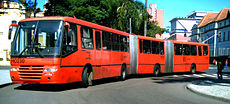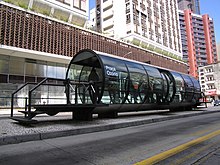Jaime Lerner
This article has multiple issues. Please help improve it or discuss these issues on the talk page. (Learn how and when to remove these messages)
|
Jaime Lerner | |
|---|---|
 Lerner in 2004 | |
| Governor of Paraná | |
| In office 1995–2002 | |
| Preceded by | Mário Pereira |
| Succeeded by | Roberto Requião |
| 76th Mayor of Curitiba | |
| In office 1989–1992 | |
| Preceded by | Edgar Dantas Pimentel |
| Succeeded by | Donato Gulin |
| 73rd Mayor of Curitiba | |
| In office 1979–1983 | |
| Preceded by | Saul Raiz |
| Succeeded by | Maurício Fruet |
| 70th Mayor of Curitiba | |
| In office 1971–1974 | |
| Preceded by | Roberto Requião |
| Succeeded by | Rafael Greca |
| Personal details | |
| Born | December 17, 1937 Curitiba, Brazil |
| Alma mater | Federal University of Paraná |
| Profession | Architect |
| Website | JaimeLerner.com |
Jaime Lerner (born December 17, 1937) is a Brazilian politician. He was the governor of the state of Paraná, in southern Brazil. He is renowned as an architect and urban planner, having been mayor of Curitiba, capital of Paraná, three times (1971–75, 1979–84 and 1989–92). In 1994, Lerner was elected governor of Paraná, and was reelected in 1998.[1]
Early life
Lerner was born into a Jewish family.[2] Originally from Łódź, Poland who emigrated to Curitiba. He graduated from the Escola de Arquitetura da Universidade Federal do Paraná; (Architecture School of the Federal University of Paraná) in 1964. In 1965, he helped create the Instituto de Pesquisa e Planejamento Urbano de Curitiba (Institute of Urban Planning and Research of Curitiba, also known as IPPUC) and participated in the design of the Curitiba Master Plan.[3]
Mayor of Curitiba
In 1988, Jaime Lerner announced his candidacy for mayor of Curitiba with only 12 days remaining before the election. During his first term, Lerner implemented the Rede Integrada de Transporte (also called bus rapid transit), and continued to implement a host of social, ecological, and urban reforms during his ensuing terms as mayor.
As mayor, Lerner employed unorthodox solutions to Curitiba's geographic challenges. Like many cities, Curitiba is bordered by floodplain. Wealthier cities in the United States, such as New Orleans and Sacramento, have built expensive and expensive-to-maintain levee systems on floodplain. In contrast, Curitiba purchased the floodplain and made parks. The city now ranks among the world leaders in per-capita park area. Curitiba had the problem of its status as a third-world city, unable to afford the tractors and petroleum to mow these parks. The innovative response was "municipal sheep" who keep the parks' vegetation under control and whose wool funds children's programs.
When Lerner became mayor, Curitiba had some bairros impossible to service by municipal waste removal. The "streets" were too narrow. Rather than abandon these people or raze these slums, Lerner began a program that traded bags of groceries and transit passes for bags of trash. The slums got much cleaner.
Similarly, Curitiba has a nearby bay that was a dumping ground that would be extremely costly to clean up. Lerner began a program that paid fishermen for any garbage they retrieved (by the pound). That way, they can make money even outside fishing season, supplementing their income. The savings to Curitiba is in the millions.
Lerner instituted many innovative social and educational programs. Barrio kids can be apprenticed to city employees if they want to avoid going to school. Although his term as mayor is not without controversy, Curitiba does not have the gangs of much more populous cities such as Rio de Janeiro.
Bus Rapid Transit


Perhaps the crown jewel of Curitiba's achievements is its Rede Integrada de Transporte Bus Rapid Transit system (called "Speedybus"). Originally, the city was given federal money to build a subway (Curitiba is not a small town), but Lerner discovered that "heavy rail" like a subway costs ten times the amount for "light rail" (trolleys), which, in turn, costs ten times a bus system, even with dedicated bus ways. The "light rail" savings usually touted to sway municipal decision makers occur because even trolleys can have relatively fewer drivers than a 40-60 passenger bus. He got Volvo to make 270 person Swedish articulated buses (300 Brazilians, says Lerner),[4] so that the problem of a lower passenger-number-to-driver ratio was no longer an issue. The city built attractive transit stops with the look and feel of train stations, and all with handicapped access equipment, inducing private firms to purchase and operate the buses. A hierarchy of buses of six sizes feed one other. The city controls the routes and fares, while the private companies hire drivers and maintain equipment.
Natural land-use patterns within the city of Curitiba support public transit systems. Buildings along the dedicated busways are up to six stories tall, gradually giving way, within a few blocks, to single story homes. This mix of densities ensures sufficient user population within walking distance of bus stops.
As Governor of Paraná
As governor of Paraná, Lerner used a policy of attracting investment to turn the state into one of Brazil's industrial hubs, generating investments of over US$20 billion between 1995 and 2001. Following upon his experience in Curitiba, Lerner focused on issues like transport, education, health, sanitation, leisure, and industrialization.
UNICEF awarded Lerner the Child and Peace Prize in 1996 for his programs "'Da Rua para a Escola'" (From the Street to School), "'Protegendo a Vida'" (Protecting Life), and "'Universidade do Professor'" (Professor's University).
In 2011, Lerner was sentenced to three-and-a-half years in prison for the illegal layoff of a public tender during his mandate as governor. He wasn't arrested due to his age.[5]
Later life
At the General Assembly of the International Union of Architects in July 2002, Lerner was elected president for a period of three years.[6] Lerner is also a professor of Urban and Regional Planning at the Universidade Federal do Paraná, his alma mater, and has been a guest professor at the University of California, Berkeley.
In April 2005, Jaime Lerner participated in the Symposium of China Bus Rapid Transit Initiative (Shanghai) to promote the BRT project in some larger cities. He was specially interviewed [7] which made an impact on mayors and urban planners across China.
Lerner is a member of the Board of Directors of World Resources Institute.[8][9]
Selected bibliography
- Acupuntura urbana (Editora Record, ISBN 85-01-06851-9, 2003)
- Urban Acupuncture. (Washington, DC: Island Press. ISBN 9781610915830, 2014)
- O vizinho: parente por parte de rua (Editora Record, ISBN 85-01-06877-2, 2005)
Awards
Lerner has won a variety of Brazilian and international prizes:
- 1990: United Nations Environmental Award, awarded by the United Nations Environmental Program (UNEP)
- 1990: Annual Prize of the International Institute for Energy Conservation (IIEC)
- 1991: Scroll of Honor, United Nations Human Settlements Programme
- 1991: Tree of Learning, IUCN
- 1994: Neutra Award: for contributions to Environmental Design.[10]
- 1996: Child and Peace Award, UNICEF
- 1997: Thomas Jefferson Foundation Medal in Architecture, University of Virginia
- 2000: Prince Claus Award, the Netherlands (2000)
- 2001: Pioneer 2001, International Council for Caring Communities (ICCC-USA)
- 2001: 2001 World Technology Award for Transportation, National Museum of Science and Industry, UK
- 2011: Leadership in Transport Award of the International Transport Forum at the OECD
- 2012: Honorary Doctorate of Arts, Plymouth University [11]
Notes
- ^ Power, Mike. "Common sense and the city: Jaime Lerner, Brazil's green revolutionary". The Guardian.
- ^ Bloom, Nate (May 21, 2010). "Jewish Stars 5/21". Cleveland Jewish News.
- ^ Adler, David (2016-05-06). "Story of cities #37: how radical ideas turned Curitiba into Brazil's 'green capital'". the Guardian. Retrieved 2018-07-03.
- ^ Acupuntura urbana, 2003
- ^ http://oglobo.globo.com/politica/ex-governador-jaime-lerner-condenado-tres-anos-meio-de-prisao-2869097
- ^ Jaime Lerner, UIA President, 2002–2005 Archived 2007-03-19 at the Wayback Machine
- ^ Listen Talks of the Father in BRT
- ^ World Resources Institute Biosketch of Jaime Lerner. Accessed March 27, 2012.
- ^ RELEASE: WRI Announces Three New Board Members Representing Business, Academia, and Government Archived 2012-04-27 at the Wayback Machine. Accessed March 27, 2012.
- ^ "Neutra Award Recipients 1980-2012". CAL POLY POMONA DEPT. OF ARCHITECTURE. Archived from the original on 2014-10-19. Retrieved 2014-10-12.
- ^ "Archived copy". Archived from the original on 2013-10-19. Retrieved 2013-10-18.
{{cite web}}: CS1 maint: archived copy as title (link)
External links
- Official website
- https://www.imdb.com/name/nm2640077
- Jaime Lerner at TED
- The Sustainable City, Jaime Lerner - Royal Institute of British Architects 2009 International Dialogues Talk
- How a Brazilian City Has Revolutionized Urban Planning
- 04.14.2010 Sustainable City, Jaime Lerner - Columbia University
- Jaime Lerner- IaaC Lecture Series 2015
